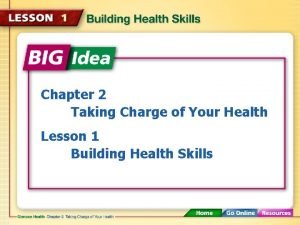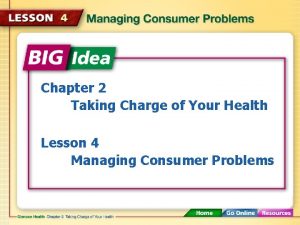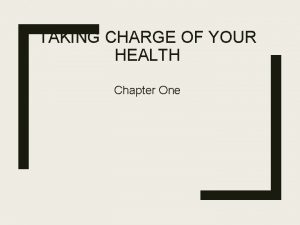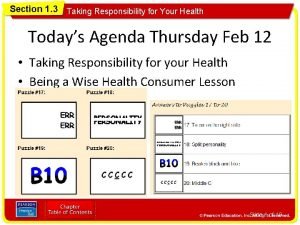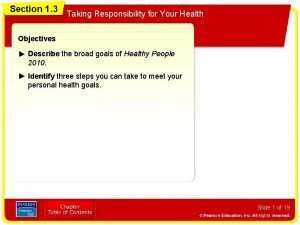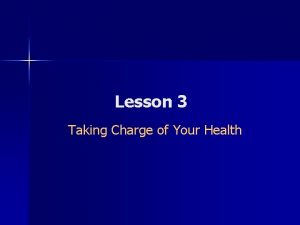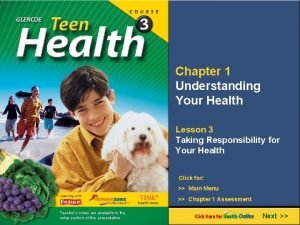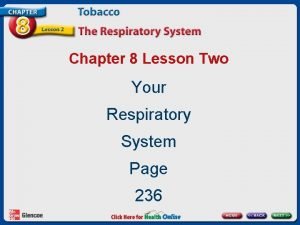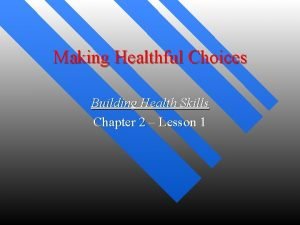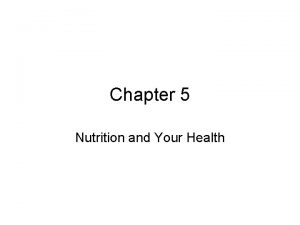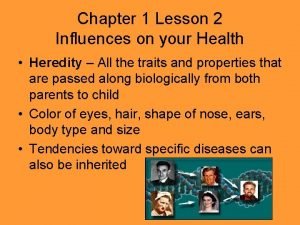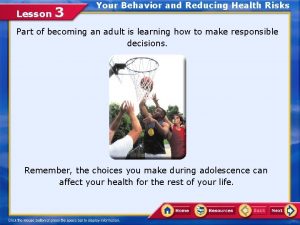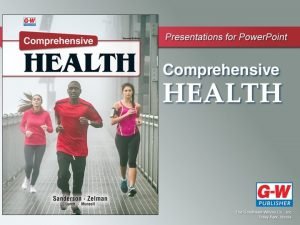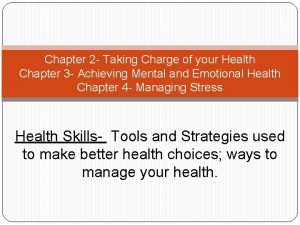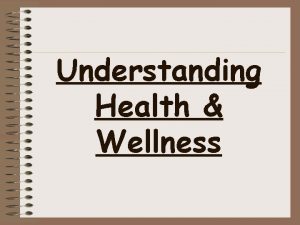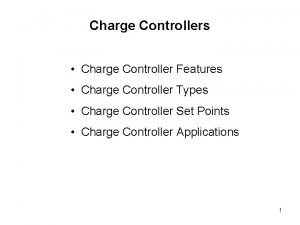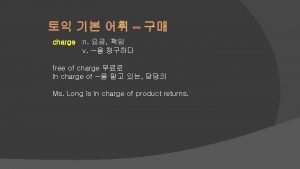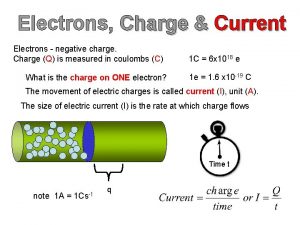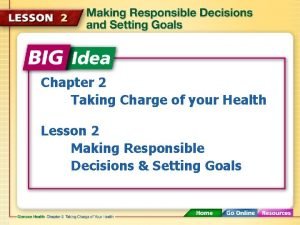CHAPTER 2 Taking Charge of Your Health HEALTH



















- Slides: 19

CHAPTER 2 Taking Charge of Your Health

HEALTH SKILLS Specific tools and strategies to maintain, protect, and improve all aspects of your health Communication Refusal Conflict Resolution Accessing Information Analyzing Influences Practicing Healthful Behaviors Stress Management Advocacy Decision Making Goal Setting

COMMUNICATION SKILLS Interpersonal- the exchange of thoughts, feelings, and beliefs between two or more people Use “I” messages to express your feelings Communicate with respect and care Be an active listener

Refusal Skills Communication strategies that can help you say no when you are urged to take part in behaviors that are unsafe or unhealthy, or that go against your values Conflict-Resolution Skills The process of ending a conflict through cooperation and problem solving

SELF- MANAGEMENT SKILLS Skills that help you reduce and manage stress in your life Practicing healthful behaviors Managing stress Stress- the reaction of the body and mind to everyday challenges and demands

WAYS TO ACHIEVE OPTIMAL HEALTH 1. Acquire Health KNOWLEDGE. 2. EXAMINE your behaviors. 3. PRIORITIZE 4. Make Responsible DECISIONS 5. COMMITMENT – promise to yourself 6. SELF-DISCIPLINE. 7. Set GOALS.

Decision Making Skills – steps that enable you to make a healthful decision Decisions May have Consequences: - Short term consequences - Long term consequences Steps In Decision Making 1) STATE THE SITUATION – what decision needs to be made? Consider all health info and who is involved

2) LIST THE OPTIONS – What are your possible choices (ask other opinions) 3) WEIGH POSSIBLE OUTCOMES- H (healthful)- health risks - E (ethical) – Reflect what is right - L (legal) – follow laws - P (parents approve) – would parents approve

4) CONSIDER VALUES- does the decision live up to your values 5) MAKE DECISION/ACT ON IT- make the decision after you have carefully prepared (good feeling) 6) EVALUATE DECISION – Reflect on the outcome

3 DECISION MAKING STYLES 1) Inactive – make no choices - (procrastinate & never decide) 2) Reactive- allow others to make choices - (listen to friends & advice from everyone) 3) Proactive- describe, identify, evaluate then makes a decision & take responsibility for decision - (Responsible Decision)

HAVE YOU HAD TO MAKE A TOUGH DECISION BEFORE? ØTake out a sheet of paper ØPlease share a time you have had to make a decision and had to use these steps in order to help you make a decision ØTake your time ØHave story be a page long

Setting Goals – something you aim for it takes planning and work TYPES OF GOALS -Short term – reach in a short period (finish research project by Friday) -Long term – plan to reach over extended period of time (graduate college) *often short term goals are steps in achieving long term goals

Action plan – multi-step strategy to identify and achieve your goals Have specific realistic goal & write it down -List the steps to reach your goal -Identify sources of help -Set reasonable time to reach your goal -Evaluate your progress by establishing checkpoints -Reward yourself for achieving your goal

Goal for the Month Project! q. Identification of realistic goal q. Clear goal statement q. Plan for reaching goal q. List of people who can provide help and support q. Evaluation or reflection on the plan

BEING A HEALTH LITERATE CONSUMER You can learn to make good consumer choices Health consumer- someone who purchases or uses health products or services Advertising- written or spoken media message designed to interest consumers in purchasing a product or service

Technique Example Hidden Message Bandwagon Group of people using a product or service Everyone is using it, and you should too Rich and Famous Product displayed in expensive home It will make you rich and famous Free gifts Redeemable coupons fro It’s too good of a deal to merchandise pass up Great outdoors Scenes nature If it’s associated with nature it must be healthy Good times People smiling and laughing The product will add fun to your life Testimonial People for whom a product has worked It worked for them, so I will work for you too

YOUR TURN… Find different commercials and advertisements that use one of the advertising techniques. Write down at least 5 in your group Circle your favorite one; send Ms. Kotelnicki the link via email! EX: http: //www. ispot. tv/ad/7 FDg/tostitos-tim

COMPARISON SHOPPING Judging the benefits of different products by comparing several factors Cost and quality Features Warranty Safety Recommendations

Malpractice- failure by a health professional to meet accepted standards Health fraud- the sale of worthless products or services that claim to prevent disease or cure other health problems. “secret formula” “miracle cure” “overnight results” “hurry this offer expires soon”
 Chapter 2 taking charge of your health
Chapter 2 taking charge of your health Taking charge of your health chapter 2
Taking charge of your health chapter 2 Taking charge of your health chapter 1
Taking charge of your health chapter 1 Your health is your responsibility
Your health is your responsibility Taking responsibility for your health quiz
Taking responsibility for your health quiz Unit 2 lesson 3 taking responsibility for your health
Unit 2 lesson 3 taking responsibility for your health Lesson 3 taking responsibility for your health
Lesson 3 taking responsibility for your health Taking charge destiny 2
Taking charge destiny 2 The illusion of taking charge examples
The illusion of taking charge examples Difference between charge and electric charge
Difference between charge and electric charge Difference between charge and electric charge
Difference between charge and electric charge Taking care of your respiratory system
Taking care of your respiratory system Give us your hungry your tired your poor
Give us your hungry your tired your poor Chapter 2 choices
Chapter 2 choices Segregation images
Segregation images Chapter 5 lesson 1 health
Chapter 5 lesson 1 health Chapter 1 lesson 2 what affects your health
Chapter 1 lesson 2 what affects your health What is an overall state of well-being or total health
What is an overall state of well-being or total health Chapter 1 lesson 3 health risks and your behavior
Chapter 1 lesson 3 health risks and your behavior The ability to locate interpret and apply information
The ability to locate interpret and apply information
